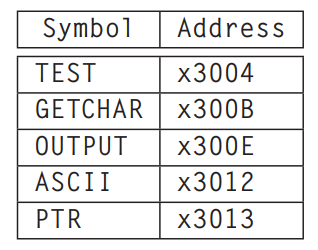Chapter 7 Assembly Language¶
Abstract
Covered in Lecture 5, 2022.7.16
Topics:
1. Assembler
2. Assembly Language
Assembly Language¶
From ISA to language.
Assembly language is a low-level language.
High-level languages tend to be ISA independent.
Low-level languages are very much ISA dependent. In fact, it is usually the case that each ISA has
only one assembly language.
The translation program is called an assembler and the translation process is called assembly.
Warning
汇编语言转为机器码的过程叫汇编, 而不是编译.
编译是对高级语言(如 C)而言.
Instructions¶
An instrution in assembly language consists of 4 parts, and two of it(Label and Comment) are optional.
Label Opcode Opearnds ; Comment
Opcodes¶
The Opcode is a symbolic name for the opcode of the correspounding LC-3 instruction so we can memorize the instruction easier. e.g. ADD, AND, or LDR rather than 0001, 0101 or 0110.
Operands¶
- The number of operands depends on the operation being performed. e.g. ADD requires 3 operands.
- A literal value must contain a symbol identifying the representation base of the number. We use # for decimal, x for hexadecimal, and b for binary. (must)
Labels¶
Labels are symbolic names used to identify memory locations that are referred explicitly in the program. In LC-3, a label consists of from 1 to 20 alphanumeric characters starting with a letter of the alphabet.(reserved words excluded)
There are 2 reasons for explicitly referring to a memory location.
- The location is the target of a branch instruction.
- The location contains a value that is loaded or stored.
Comments¶
Comments are messages intened only for human consumption. They have no effect on the translation process and indeed are not acted on by the LC-3 assembler.
They are identified by semicolons. A semicolon signifies the rest of the line is a commment and is to be ignored by the assembler.
Pseudo-Ops¶
Pseudo-op is also called assembler directive, and it dose no t refer to an operation that will be performed by the program during execution.
.ORIG¶
.OGIR tells the assembler where in memory to place the LC-3 program.(to specify the start address)
.FILL¶
.FILL tells the assembler to set aside the next location in the program and initiallize it with the value of the operand. The value can be either a number or a label. e.g. x3006: .FILL x0030 then x0030 will be stored in the location x3006.
.BLKW¶
.BLKW tells the assembler to set aside some number of sequential memory locations.(i.e. a BLocK of Words) e.g. x3007: .BLKW 1 then the location x3007 will be set aside.
.STRINGZ¶
.STRINGZ tells the assembler to initiallize a sequence of n+1 memory locations. The argument is asquence of n characters inside double quotation marks. The first n words of memroy are initiallize with the zero-extended ASCII codes of the correspounding characters in the string. The final word is 0.(\0)
.END¶
.END tells the assembler it has reached the end of the program.
Note
Note does not stop the program during execution. In fact, .END does not even exist at the time of execution.
The Assembly Process¶
It's the job of the LC-3 assembler to perform the translation from the LC-3 assembly language into a machine language program.
We use the command assemble and it requires the filename of your assembly language program as an argument, and it produces the file outfile, which is in the ISA of LC-3.
assemble soutiona1.asm outfile
A Two-Pass Process¶
The First Pass: Creating the Symbol Table¶
The symbol table is simply a correspoundence of symbolic names with their 16-bit memory addresses. In the first pass we identify each label with the memory address of its assigned entry.
e.g.

The Second Pass: Generating the Machine Language Program¶
The second pass consists of going through the assembly language line by line, with the help of the symbol table. At each line, the assembly language instruction is translated into an LC-3 machine language instruction.
LD
The only part of the LD instruction left to do is the PCoffset. So it's necessary that the address of the source is no more than +256 or -255 memory locations from the LD instruction. Otherwise, assembly error.
Beyond the Assembly of a Single Assembly Language Program¶
The Executable Image¶
When a computer begins execution of a program, the entity being executed is called a executable image. The executable image is created from modules often created independently by several different programmers(also different object files).
Example
we write PTR .FILL STARTofFILE in the program but there is no such a label in our program while the label is in another module by different programmer. We can use .EXTERNAL STARTofFILE, then at link time when all modules are combined, the linker will find the symbol table entry.